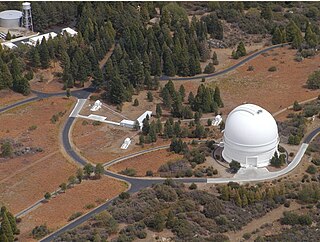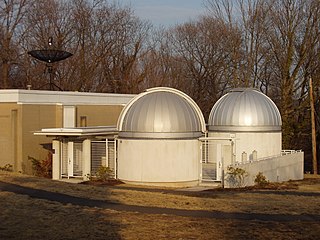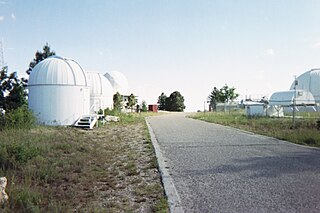
The Kitt Peak National Observatory (KPNO) is a United States astronomical observatory located on Kitt Peak of the Quinlan Mountains in the Arizona-Sonoran Desert on the Tohono Oʼodham Nation, 88 kilometers (55 mi) west-southwest of Tucson, Arizona. With more than twenty optical and two radio telescopes, it is one of the largest gatherings of astronomical instruments in the Earth's northern hemisphere.

Lowell Observatory is an astronomical observatory in Flagstaff, Arizona, United States. Lowell Observatory was established in 1894, placing it among the oldest observatories in the United States, and was designated a National Historic Landmark in 1965. In 2011, the Observatory was named one of "The World's 100 Most Important Places" by Time Magazine. It was at the Lowell Observatory that the dwarf planet Pluto was discovered in 1930 by Clyde Tombaugh.

Yerkes Observatory is an astronomical observatory located in Williams Bay, Wisconsin, United States. The observatory was operated by the University of Chicago Department of Astronomy and Astrophysics from its founding in 1897 until 2018. Ownership was transferred to the non-profit Yerkes Future Foundation (YFF) in May 2020, which began millions of dollars of restoration and renovation of the historic building and grounds. Yerkes re-opened for public tours and programming in May, 2022. The April, 2024 issue of National Geographic magazine featured a story about the Observatory and ongoing work to restore it to relevance for astronomy, public science engagement and exploring big ideas through art, science, culture and landscape. The observatory offers tickets to programs and tours on its website.

The Mount Wilson Observatory (MWO) is an astronomical observatory in Los Angeles County, California, United States. The MWO is located on Mount Wilson, a 5,710-foot (1,740-meter) peak in the San Gabriel Mountains near Pasadena, northeast of Los Angeles.

Palomar Observatory is an astronomical research observatory in the Palomar Mountains of San Diego County, California, United States. It is owned and operated by the California Institute of Technology (Caltech). Research time at the observatory is granted to Caltech and its research partners, which include the Jet Propulsion Laboratory (JPL), Yale University, and the National Astronomical Observatories of China.

The Washburn Observatory is an astronomical observatory located at 1401 Observatory Drive on the University of Wisconsin–Madison campus in Madison, Wisconsin, United States. Completed in 1881, it was a major research facility for about 50 years. Today, it is home to the UW-Madison College of Letters and Science Honors Program, while the telescope remains in use by students in introductory astronomy courses and the general public during open houses and viewings.

The Dominion Astrophysical Observatory, located on Observatory Hill, in Saanich, British Columbia, was completed in 1918 by the Canadian government. The Dominion architect responsible for the building was Edgar Lewis Horwood. The main instrument is the 72-inch-aperture (1.83 m) Plaskett telescope, proposed and designed by John S. Plaskett in 1910 with the support of the International Union for Cooperation in Solar Research.

The David Dunlap Observatory (DDO) is an astronomical observatory site in Richmond Hill, Ontario, Canada. Established in 1935, it was owned and operated by the University of Toronto until 2008. It was then acquired by the city of Richmond Hill, which provides a combination of heritage preservation, unique recreation opportunities and a celebration of the astronomical history of the site. Its primary instrument is a 74-inch (1.88 m) reflector telescope, at one time the second-largest telescope in the world, and still the largest in Canada. Several other telescopes are also located at the site, which formerly also included a small radio telescope. The scientific legacy of the David Dunlap Observatory continues in the Dunlap Institute for Astronomy & Astrophysics, a research institute at the University of Toronto established in 2008.

The Cincinnati Observatory, known locally as Mt. Lookout Observatory, is located in Cincinnati, Ohio on top of Mount Lookout. It consists of two observatory buildings housing an 11-inch (28 cm) and 16 inch (41 cm) aperture refracting telescope. It is the oldest professional observatory in the United States. It was a key facility for astronomical research and education at the University of Cincinnati and currently operates as a 19th-century observatory. There are regular viewings through both historical telescopes as well as tours and additional programs. The observatory also has an extensive outreach program, providing astronomical education for the Ohio/Kentucky/Indiana region.

The Institute of Astronomy (IoA) is the largest of the three astronomy departments in the University of Cambridge, and one of the largest astronomy sites in the United Kingdom. Around 180 academics, postdocs, visitors and assistant staff work at the department.

The Allegheny Observatory is an American astronomical research institution, a part of the Department of Physics and Astronomy at the University of Pittsburgh. The facility is listed on the National Register of Historic Places and is designated as a Pennsylvania state and Pittsburgh History and Landmarks Foundation historic landmark.

South African Astronomical Observatory (SAAO) is the national centre for optical and infrared astronomy in South Africa. It was established in 1972. The observatory is run by the National Research Foundation of South Africa. The facility's function is to conduct research in astronomy and astrophysics. The primary telescopes are located in Sutherland, which is 370 kilometres (230 mi) from Observatory, Cape Town, where the headquarters is located.

The MMT Observatory (MMTO) is an astronomical observatory on the site of Fred Lawrence Whipple Observatory. The Whipple observatory complex is located on Mount Hopkins, Arizona, US in the Santa Rita Mountains. The observatory is operated by the University of Arizona and the Smithsonian Institution, and has a visitor center in nearby Amado, Arizona. The MMTO is the home of the MMT, which has a primary mirror 6.5 m in diameter. The name comes from the six smaller mirrors originally used before the single primary mirror was installed in 1998. The primary mirror has a special lightweight honeycomb design made by the University of Arizona's Steward Observatory Mirror Laboratory. The MMT is housed in a building which allows the walls and roof around the telescope to be completely rolled back, allowing it to cool down very quickly in order to improve observation.

Mount Laguna Observatory (MLO) is an astronomical observatory owned and operated by San Diego State University (SDSU). The telescope was operated in partnership with the University of Illinois at Urbana-Champaign (UIUC) until 2000. MLO is located approximately 75 kilometers (47 mi) east of downtown San Diego, California (USA) on the eastern edge of the Cleveland National Forest in the Laguna Mountains on the SDSU Astronomy Campus near the hamlet of Mount Laguna. MLO was dedicated on June 19, 1968, seven years after SDSU's Department of Astronomy became an independent academic department of SDSU's College of Sciences. The dedication took place during the 1968 summer meeting of the Astronomical Society of the Pacific. Currently SDSU is working with University of Kansas (KU), and UNC Chapel Hill on various projects. MLO also engages with the public through a series of scientific outreach efforts such as the summer visitors program (SVP). SVP's take place on select dates throughout the summer months and include scientific demonstrations in the museum / gift shop, an introductory lecture on astronomy, and a stargazing session using a myriad of telescopes such as the 0.52 m Reginald Buller 21-inch Visitors' Telescope. The SVP is predominantly run by graduate students within the SDSU Astronomy Master's program.

The Dyer Observatory, also known as the Arthur J. Dyer Observatory, is an astronomical observatory owned and operated by Vanderbilt University. Built in 1953, it is located in Nashville, Tennessee, and is the only university facility not located on the main campus in Nashville. The observatory is named after Arthur J. Dyer, who paid for the observatory's 24-foot (7.3 m)-wide dome, and houses a 24-inch (610 mm) reflecting telescope named for astronomer Carl Seyfert. Today, the observatory primarily serves as a teaching tool; its mission is to interest the public in the fields of astronomy, science and engineering. The observatory was listed on the National Register of Historic Places on March 6, 2009.

The Warner and Swasey Observatory is the astronomical observatory of Case Western Reserve University. Named after Worcester R. Warner and Ambrose Swasey, who built it at the beginning of the 20th century, it was initially located on Taylor Road in East Cleveland, Ohio, USA. The observatory, which at that time housed a 9.5-inch (24 cm) refractor, was donated in 1919 to the Case School of Applied Science. The newer 24-inch (61 cm) Burrell Schmidt telescope was built in 1939.

The Yale University Observatory, also known as the Leitner Family Observatory and Planetarium, is an astronomical observatory owned and operated by Yale University, and maintained for student use. It is located in Farnham Memorial Gardens near the corner of Edwards and Prospect Streets, New Haven, Connecticut.

Mount Lemmon Observatory (MLO), also known as the Mount Lemmon Infrared Observatory, is an astronomical observatory located on Mount Lemmon in the Santa Catalina Mountains approximately 28 kilometers (17 mi) northeast of Tucson, Arizona (US). The site in the Coronado National Forest is used with special permission from the U.S. Forest Service by the University of Arizona's Steward Observatory, and contains a number of independently managed telescopes.

J A Jones Hoober Observatory is a privately owned observatory located in South Yorkshire, England near to the villages of Hoober and Wentworth, 4 miles (6.4 km) North-northwest of Rotherham. It can be found about 300 metres (0.19 mi) east of Hoober Stand. The observatory is owned and operated by Mexborough & Swinton Astronomical Society (NPO).




















